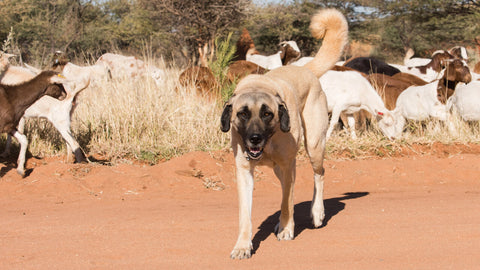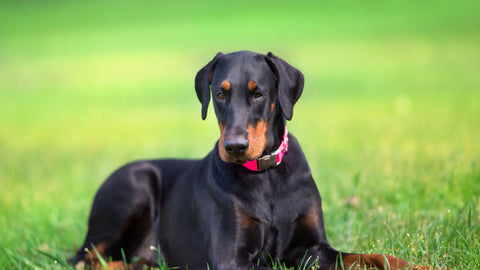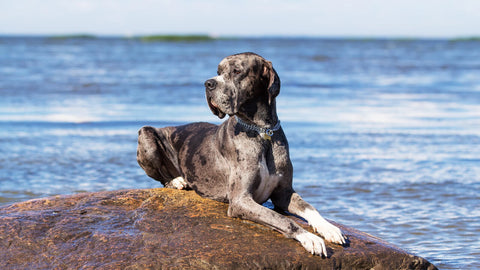Contents
- Introduction to the Kangal
- Appearance of the Kangal
- Coat and colours of the Kangal
- How big can a Kangal get
- The character of the Kangal
- Training the Kangal
- For whom is the Kangal suitable
- Is the Kangal a family dog
- Care of the Kangal
- Nutrition of the Kangal
- How much does a Kangal shed
- How old does a Kangal get
- Typical diseases of the Kangal
- How much does a Kangal puppy cost
- What to look out for when buying a Kangal
- Kangal profile
Introduction to the Kangal
The Kangal, also known as the Kangal Shepherd or Kangal Sheepdog, originates from Turkey and is considered to be one of the oldest and purest dog breeds in the world. Originally, it was bred to protect livestock from predators such as wolves and bears. Its impressive size and strong protective instincts make it a unique and extremely reliable watchdog. The Kangal enjoys a special status, particularly in its home region of Sivas, where it is revered as a national dog.
Appearance of the Kangal
The Kangal is characterised by its stately, powerful appearance. Its body is well-proportioned, muscular and robust, which makes it an excellent working dog. It has a broad head with a strong muzzle and dark, almond-shaped eyes that reflect a watchful, calm and serious nature. Characteristic is its black face mask, which stands out particularly clearly on its usually lighter fur. The ears are medium-sized, triangular and hang down close to the head.
Coat and colours of the Kangal
The Kangal's coat is short to medium-length and very dense. It provides excellent protection against extreme weather conditions, both cold and heat. The most common coat colour is a light beige or fawn colour, which is described as ‘sand-coloured’. The black mask that frames the Kangal's face is a distinctive feature of this breed. Occasionally, white markings can also be found on the chest, paws or tip of the tail, but the uniform beige colour dominates.
How big can a Kangal get?
The Kangal is one of the largest dog breeds in the world. Males reach a shoulder height of about 74 to 85 centimetres, while bitches remain slightly smaller and grow to between 71 and 79 centimetres. Their weight is also impressive: males weigh between 50 and 65 kilograms, while bitches are slightly lighter at 40 to 55 kilograms. The size of the Kangal is an important factor in its role as a protector of large herds of livestock.
The character of the Kangal
The Kangal is an extremely self-confident, calm and independent dog. Its strong protective instincts make it an excellent watchdog, defending its herd or family with courage and determination. At the same time, however, it is also very well-balanced and does not tend to bark excessively or behave aggressively unless there is a real danger. The Kangal is usually suspicious of strangers, but never aggressively so. It forms a close bond with its family and shows great loyalty and devotion towards its caregivers.
Training the Kangal
Training a Kangal requires a lot of experience, patience and consistency. Due to their independent and sometimes stubborn character, it is important to start consistent and loving training early on. The Kangal must learn clear rules and boundaries, otherwise they will tend to make their own decisions. Due to their protective instinct, it is also important to socialise them well so that they learn to distinguish between real threats and harmless situations. A harsh hand is not helpful here – instead, training should be based on trust, respect and positive reinforcement.
Who is the Kangal suitable for?
A Kangal is not suitable for every dog owner. Due to its size, protective instinct and independent nature, it needs clear leadership and sufficient space. It is ideal for experienced dog owners who live in rural areas, where it can fulfil its natural role as a guard dog. People who spend a lot of time outdoors and can provide the dog with sufficient exercise and stimulation are well suited to having a Kangal. They need a strong and patient owner who is willing to invest time in training and care.
Is the Kangal a family dog?
Yes, the Kangal can be a good family dog if they are socialised and trained properly. It is very loyal and protective of its family, especially children. Its calm and patient nature makes it a gentle companion. However, small children should never be left unattended with such a large dog, as the Kangal could unintentionally cause harm due to its size and strength. Furthermore, the family should be prepared to provide the Kangal with sufficient space and exercise.
Grooming the Kangal
The Kangal is relatively easy to care for when it comes to its coat. Regular brushing is enough to keep its short to medium-length fur in good condition and remove loose hairs. However, more intensive brushing is required during the moult, which occurs twice a year, to remove the dead fur. The ears, teeth and claws should also be checked and cleaned regularly. Especially for such a large dog, it is important to keep its claws from getting too long to avoid joint problems.
Nutrition of the Kangal
The Kangal's diet should be balanced and tailored to its size and activity level. High-quality dry or wet food that is high in meat and contains no unnecessary fillers is ideal. In addition, raw meat (BARF), rice, vegetables or special food supplements can be fed. The Kangal does not tend to be overweight, but as with all large breeds, it is important to control the amount of food and the quality of the nutrients to prevent joint problems.
How much does a Kangal shed?
The Kangal sheds all year round, but especially during the seasonal coat changes in spring and autumn. During these times, increased brushing is needed to maintain the coat and remove the loose hairs. Outside of these phases, however, shedding is kept to a minimum. A clean coat also ensures that the dog carries less dirt into the house.
How old does a Kangal become?
The average life expectancy of a Kangal is between 12 and 15 years, which is quite high for such a large dog. A healthy diet, sufficient exercise and regular veterinary check-ups will help to ensure that your Kangal can live a long and healthy life.
Typical diseases of the Kangal
Like many large dog breeds, the Kangal is prone to hip dysplasia (HD) and elbow dysplasia (ED). These joint disorders can cause pain and restricted mobility. Responsible breeding that pays attention to the health of the parent animals can reduce the risk of such disorders. Other age-related problems such as arthritis or eye problems can also occur in Kangals.
How much does a Kangal puppy cost?
The cost of a Kangal puppy varies greatly depending on the breeder, parentage and region. However, you should generally expect to pay between CHF 1000.00 and CHF 2000.00. Reputable breeders invest a lot in the health and rearing of their dogs, which is reflected in the price. It is important to choose a reputable breeder who values healthy breeding.
What should you look out for when buying a Kangal?
When buying a Kangal puppy, you should make sure that the breeder is reputable and responsible. The parent animals should be healthy and tested for typical hereditary diseases such as hip and elbow dysplasia. The puppy should be well socialised and have grown up in a clean, well-kept environment. When handed over, the puppy should also be vaccinated, chipped and dewormed. Visiting the breeder and getting to know the parent animals gives a good impression of the breeding conditions.
Kangal profile
Origin: Turkey
Size: Males 74-85 cm, females 71-79 cm
Weight: Males 50-65 kg, females 40-55
Coat colour: Beige, sand-coloured, with black mask
Life expectancy: 12-15 years
Character: Calm, self-confident, protective, loyal
Use: guard dog, herd protection dog
Care: Easy, just needs regular brushing
Training: Consistent, experienced leadership necessary
Suitable for: Experienced dog owners, rural environment




Comments (0)
There are no comments for this article. Be the first one to leave a message!